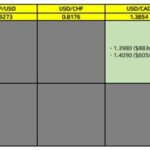GBPUSD Forecast: Sideways Market Analysis Amidst Fear Sentiment
Tháng 4 18, 2025
Unlocking Forex Potentials: Key FX Option Expiry Dates for April 2025
Tháng 4 18, 2025The U.S. Dollar’s Dynamic Movements Amid Asia-Pacific Trade Tensions
In the early hours of April 18, 2025, a notable trend of light selling pressure on the U.S. dollar was observed during the Asia-Pacific trading session. The dollar demonstrated signs of weakening but also glimpses of resilience, particularly in its fluctuations against major currencies. The USD/JPY pair, for instance, plunged to a seven-month low around 141.62 before clawing its way up to 142.61, spurred on by remarks from Japan’s Economy Minister Ryosei Akazawa, which sparked recovery sentiments in the overall dollar performance during this period.
The Broader Impact of Trade Tensions
The ongoing trade hostilities between the United States and China continue to cast a long shadow over market sentiment across the Asia-Pacific region. Fitch Ratings, along with S&P Global, has pointed out the detrimental effects of U.S. tariff strategies and the intensifying U.S.-China trade war on the economic landscape of Asia-Pacific nations. Challenges posed by increased tariffs, retaliatory measures from China, and disrupted trade routes threaten to stifle growth in export-reliant economies of the region, giving rise to heightened market volatility and caution among investors. For a deeper analysis of how these elements intertwine, you can read about China’s strategic moves in the ongoing trade landscape here.
Monetary Policy Expectations Influencing Market Sentiment
The prevailing trepidation surrounding the U.S. dollar and various regional currencies is also influenced by anticipated monetary policy adjustments. S&P Global indicates that the U.S. Federal Reserve is likely to adopt a gradual approach toward easing its monetary policy, potentially executing a 25 basis point cut later in 2025. Despite this subdued outlook, persistent inflationary pressures tied to tariffs in the U.S. provide a baseline level of support for the dollar, yet they simultaneously render market participants cautious. In contrast, several Asian currencies, including the Singapore dollar and the Chinese renminbi, are experiencing downward momentum, exacerbated by the sluggish growth trends and ongoing trade-related uncertainties. The current stock market movements reflect these dynamics and can be monitored closely for potential investment opportunities here.
Key Currency Movements and Projections
As we analyze the currency movements, the USD/CNY (Chinese yuan) continues to bear the brunt of trade tensions. However, experts anticipate it will oscillate within a broad range of 7.00 to 7.40 throughout 2025. Notably, interventions by the People’s Bank of China are expected to mitigate drastic depreciation. Furthermore, economic stimulus measures may eventually pave the way for a recovery in the yuan.
Similarly, the USD/SGD (Singapore dollar) is projected to exhibit a mildly bullish trend for the dollar, trading in the vicinity of 1.34 to 1.37. This outlook is influenced by low inflationary conditions and expectations of domestic monetary easing, which could further exert downward pressure on Singapore’s currency.
On the other hand, the USD/TWD (Taiwan dollar) is expected to maintain a neutral stance within a tight trading range. Mixed drivers such as capital outflows and geopolitical uncertainties are keeping the Taiwan dollar relatively stable.
Conclusion: Navigating Uncertain Economic Waters
In conclusion, the subtle selling of the U.S. dollar observed during the Asia-Pacific trading hours is reflective of a complex interplay between ongoing U.S.-China trade tensions, tentative attempts at recovery in the dollar, and significant pressure faced by regional currencies as they navigate a landscape marked by slower growth and diverging monetary policies. Market participants remain vigilant in monitoring tariff developments, central bank policy shifts, and geopolitical dynamics that could further influence not only the trajectory of the dollar but also the stability of currencies across the Asia-Pacific region. For those interested in a broader conversation about the importance of value investing during such volatile times, exploring Greenblatt’s insights can be invaluable here. Navigating these uncertain economic waters will require a careful assessment of these factors as they continue to evolve.
